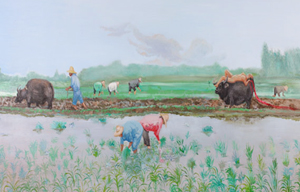Starting young
 |
|
A museum guide gives children and their parents a brief tour of calligraphic art at the National Art Museum of China. Jiang Dong / China Daily |
"Most households buy ready-made couplets at supermarkets. The characters are written in gold and in bad taste, and there is no creativity," says Pang Guixin, deputy director of NAMOC's public education department.
"The program gives people the chance to learn about the true beauty of calligraphy. We hope they can pick up the brush and create a New Year couplet of their own."
Pang's department has been organizing educational activities since late 2004. But it was not until recent years that they have introduced regular programs catering to children's interests and families' demands. They also offer volunteer guide training for schoolteachers and children aged between 8 and 12.
The couplet-writing program is part of the annual "Celebrating the Lunar New Year" series that offer experiential events related to folk customs. It received 70 online family applications, more than three times the maximum number of 20.
From the post-program questionnaires, Pang discovers that many parents dare not visit museums because they don't know how to introduce the displays to their children, or to inspire them with the exhibits. She believes the educational programs provide parents useful approaches.
"Only when the parents realize how to make full use of museums, will they bring their children here," she says.
The Ullens Center for Contemporary Art in Beijing's 798 Art District also organizes programs to aid parents in cultivating an appreciation for art in their children.
Despite the freezing weather, UCCA's educational workshops drew dozens of parents and children with their cross-disciplinary activities. There are wide-ranging programs, from Spring Festival rituals to Pompeii's fresco painting art and even the world of owls.
"We aim to create a free atmosphere for children to engage with arts, science and other subjects. All the programs end with children creating a work of art that is relevant to the theme," says Song Xi, coordinator of UCCA's education and public program department.
The department also curates special programs in conjunction with other existing grand exhibitions such as the ongoing ON/OFF: China's Young Artists in Concept and Practice. They have designed a children's exhibition activity booklet.
It tells the story of a famous artist who visits the exhibition and takes many photographs. But when he is back home, he forgets the title of four works on display. The booklet contains images, each revealing a part of the work and their descriptions.
It is like a treasure hunt. Parents and children visiting the exhibition are to follow the clues in the booklet to find out the correct answer. The clues lead them to different exhibition halls so that at the end of their hunt, they have seen almost all the exhibits.
The center will launch workshops in March hosted by artists, who are also parents, and are conversant in communicating with other parents and children.
Song says their programs are in line with UCCA's mission to build a family-friendly art center.
"Many parents do not enter art galleries if there are no educational activities. They perceive art and artists to be high up there. We try to inject the idea that art is everywhere, and people can play with it," she explains.
Sheng Jianghua, guest teacher of "Mysterious friend - owl", a "Touching Nature" series program, is an expert at merging knowledge of nature with creating artworks, reciting poems and acting. She has held activities in residential communities, cafes and children's activity centers.
"The UCCA program provides a unique and amazing experience to have more connection with art.
"I find parents do not place much emphasis on implanting artistic knowledge to their children. But they've come to accept that science and art are not mutually exclusive. Nature in itself is a big work of art," she says.
She encourages parents and children to go outdoors after the program. "I tell them owls can be seen at the Temple of Heaven. There used to be dozens of owls, but this year we spot only a few. If they go there, they will observe how human's activities have worsened the animals' living condition."
Pang from the NAMOC hopes this year they can curate periodic educational programs, touching on NAMOC's immense collections, such as traditional Chinese toys and oil paintings.
"A lot of people don't even know the museum boasts a rich storage of old toys," she says. "We believe an art museum not only benefits art lovers. It should move closer to a wider population. It should take the initiative to make its resources more accessible."
Contact the writer at linqi@chinadaily.com.cn.

















